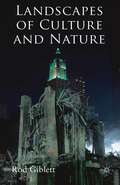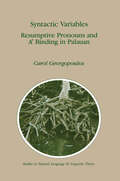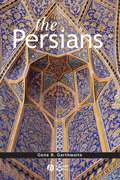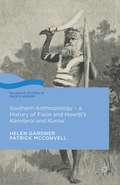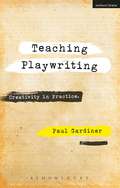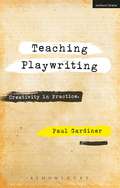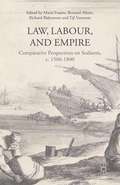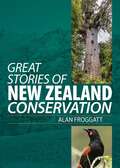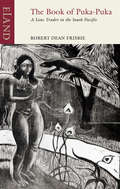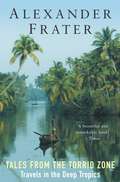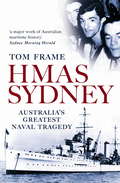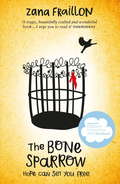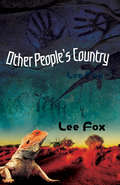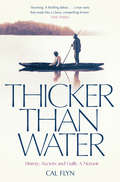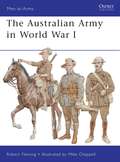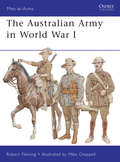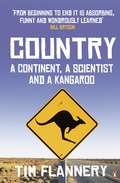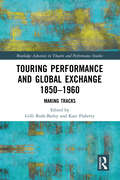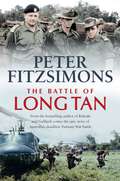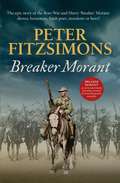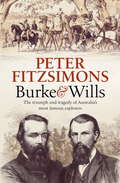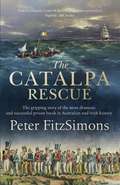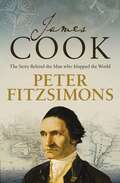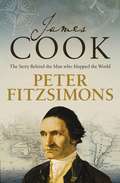- Table View
- List View
Landscapes of Culture and Nature
by R. GiblettA bold and exciting exploration of the relationship and interactions between humans, the human landscape and the earth, looking at a diverse range of case studies from the nineteenth-century city to the Asian tsunami and Hurricane Katrina.
Syntactic Variables: Resumptive Pronouns and A′ Binding in Palauan (Studies in Natural Language and Linguistic Theory #24)
by C. GeorgopoulosThis book represents the culmination of an extended period of field work on the Palauan language, carried out while I was a graduate student at the University of California at San Diego. The book was born as a short term paper written in 1982; from a forgettable infancy, that paper grew and grew, reaching the age of majority in my dissertation at the end of 1985. Some of its offspring have gone off on their own, as indepen dent papers, as course materials, or as thoughts that have not yet com pletely materialized. Some have been disowned. The full adulthood of this study of Palauan is realized in the present book. Virtually every section of the dissertation has been rewritten, updated, or otherwise (I hope) improved. Where the dissertation was still struggling with various problems, the book has found solutions. The aim of the book remains, however, to give broad coverage of Palauan, with emphasis on A' binding, rather than to focus narrowly on a few highly specific theoretical issues. I hope to have achieved a balance between presenting the language clearly and nonprejudicially, and deal ing with various of its properties in current theoretical terms. If I have, the book should prove to be a resource for further typological study of the phenomena it describes.
The Persians (Peoples of Asia #6)
by Gene R. GarthwaiteThe Persians is a succinct narrative of Iranian history from the time of Cyrus the Great in 560BC to the present day. A succinct narrative of Iranian history from the time of Cyrus the Great in 560BC to the present day. Traces events from the rise of the Persian empire, through competition with Rome and conquest by the Arabs, through to the re-establishment of a Persian state in the sixteenth century, and finally the Islamic Revoltuion on 1979 and the establishment of the current Islamic Republic. Uses the most recent scholarship to examine Iran's political, social and cultural history. Focuses on rulership as a central theme in Iranian identity. Also shows how land, language and literature relate to Iranian identity.
Southern Anthropology - a History of Fison and Howitt’s Kamilaroi and Kurnai: A History Of Fison And Howitt's Kamilaroi And Kurnai (Palgrave Studies in Pacific History)
by Helen Gardner Patrick McConvellSouthern Anthropology, the history of Fison and Howitt's Kamilaroi and Kurnai is the biography of Kamilaroi and Kurnai (1880) written from both a historical and anthropological perspective. Southern Anthropology investigates the authors' work on Aboriginal and Pacific people and the reception of their book in metropolitan centres.
Teaching Playwriting: Creativity in Practice
by Paul GardinerPlaywriting is a skill under-explored in the classroom, despite the strong evidence that it's an engaging and rewarding activity for young people. Teaching Playwriting addresses this gap and is an essential resource for teachers wanting to gain the skills and confidence necessary to introduce playwriting to their students. Based on rich research and clearly explained theoretical concepts, the book explores the lessons from creativity theory that will provide the teacher with the skills and knowledge necessary to empower students' writing and creativity. It also includes extensive practical activities and writing exercises to develop students' playwriting proficiency and creative capacity.Discussing key concepts in playwriting such as idea, dialogue, character, action and structure, the book enables teachers to respond to the unique learning needs of their students and help them tell their stories and reach their potential as young playwrights.
Teaching Playwriting: Creativity in Practice
by Paul GardinerPlaywriting is a skill under-explored in the classroom, despite the strong evidence that it's an engaging and rewarding activity for young people. Teaching Playwriting addresses this gap and is an essential resource for teachers wanting to gain the skills and confidence necessary to introduce playwriting to their students. Based on rich research and clearly explained theoretical concepts, the book explores the lessons from creativity theory that will provide the teacher with the skills and knowledge necessary to empower students' writing and creativity. It also includes extensive practical activities and writing exercises to develop students' playwriting proficiency and creative capacity.Discussing key concepts in playwriting such as idea, dialogue, character, action and structure, the book enables teachers to respond to the unique learning needs of their students and help them tell their stories and reach their potential as young playwrights.
Law, Labour, and Empire: Comparative Perspectives on Seafarers, c. 1500-1800
by Maria FusaroSeafarers were the first workers to inhabit a truly international labour market, a sector of industry which, throughout the early modern period, drove European economic and imperial expansion, technological and scientific development, and cultural and material exchanges around the world. This volume adopts a comparative perspective, presenting current research about maritime labourers across three centuries, in the Mediterranean Sea and the Atlantic and Indian Oceans, to understand how seafarers contributed to legal and economic transformation within Europe and across the world. Focusing on the three related themes of legal systems, labouring conditions, and imperial power, these essays explore the dynamic and reciprocal relationship between seafarers' individual and collective agency, and the social and economic frameworks which structured their lives.
The Book of Puka-Puka: A Lone Trader in the South Pacific
by Robert Dean FrisbieIn 1924, Robert Frisbie arrived on the island of Puka-Puka, one of the most remote in the South Pacific, to run a trading post. Within months he had learned the language and become absorbed into the ways of its ancient, indigenous community – fishing, picnicking, swimming, sleeping and falling in love. Fortunately for us he also had a pitch-perfect ear for stories.Before the book is done, we feel the power of the surf and the coral reefs, hear death chants and witness thirty torch-lit canoes setting out to net flying fish at night. Frisbie’s interest in and love for the culture of this island and its inhabitants are infectious.
Diary of a Christmas Wombat
by Jackie FrenchA hilarious view of Christmas as seen through the eyes of Mothball the wombat.
Tales from the Torrid Zone: Travels in the Deep Tropics (Vintage Departures Ser.)
by Alexander FraterPart memoir, part travelogue, Tales From the Torrid Zone is rooted in Alex Frater's birthplace, the tiny tropical republic of Vanuatu where his father ran its hospital and his mother, in her front garden, built its first school. From this obscure South Seas group he ranges over the hot, wet, beautiful swathe of the world that has haunted him ever since – dines with a tropical queen in a leper colony, makes his way across tropical Africa (and two civil wars) in a forty-four-year-old flying boat, delivers a new church bell to a remote Oceanian island and visits scores of countries to learn about their history, politics, medicine, flora and fauna (including the remarkable role of the coconut in tropical life). But, as becomes plain, the torrid zone is not just a geographical phenomenon, it’s also a state of mind. The result is a witty, entertaining and immensely readable book from a fine storyteller.
HMAS Sydney
by Tom FrameThe complete and authoritative account of the sinking of the HMAS Sydney, and the recent finding of her wreck.On 19 November 1941, the pride of the Australian Navy, the light cruiser Sydney, fought a close-quarters battle with the German armed raider HSK Kormoran off Carnarvon on the West Australian coast. Both ships sank – and not one of the 645 men on board the Sydney survived. Was Sydney’s captain guilty of negligence by allowing his ship to manoeuvre within range of Kormoran’s guns? Did the Germans feign surrender before firing a torpedo at the Sydney as she prepared to despatch a boarding party? This updated edition covers the recent discovery of the wreck – with the light this sheds on the events of that day 67 years ago, and the closure it has brought to so many grieving families. ‘Tom Frame has produced the most comprehensive and compelling account of the loss of HMAS Sydney to date. His judgements are fair and his conclusions reasoned. If you only read one book on this tragic event in Australian naval history, and want all the facts and theories presented in a balanced way, Tom Frame’s book is for you’ - Vice Admiral Russ Shalders AO CSC RANR Chief of Navy, 2005-08.
The Bone Sparrow
by Zana FraillonWinner of the CILIP Amnesty Honour 2017.Shortlisted for the Guardian Children's Fiction Prize and the CILIP Carnegie Medal 2017.Perfect for fans of THE BOY IN THE STRIPED PYJAMAS. This is a beautiful, vivid and deeply moving story about a refugee boy who has spent his entire life living in a detention centre. This novel reminds us all of the importance of freedom, hope, and the power of a story to speak for anyone who's ever struggled to find a safe home.'...a special book' - Morris Gleitzman, author of the acclaimed ONCE seriesBorn in a refugee camp, all Subhi knows of the world is that he's at least 19 fence diamonds high, the nice Jackets never stay long, and at night he dreams that the sea finds its way to his tent, bringing with it unusual treasures. And one day it brings him Jimmie.Carrying a notebook that she's unable to read and wearing a sparrow made out of bone around her neck - both talismans of her family's past and the mother she's lost - Jimmie strikes up an unlikely friendship with Subhi beyond the fence. As he reads aloud the tale of how Jimmie's family came to be, both children discover the importance of their own stories in writing their futures.
Other People's County
by Lee FoxFifteen-year-old Lola lives in a quiet, rural town with her mother, her over-achieving older brother, Daniel, and her annoying but lovable younger brother, Toby. When Lola’s mother receives an offer of a few months’ work as a store manager on a remote Aboriginal community, the family – except for Daniel who stays home to finish exams – fly to Wandana with a sense of anticipation and adventure. But Wandana is no holiday resort. In the red dust and blazing heat of central Australia, Lola and her family are confronted with enormous social and cultural differences, as well as a dark form of racism they have never encountered before. Misunderstanding and violence threaten to end their adventure soon after it begun. Yet from somewhere in this harsh place, hands reach out to the newcomers. Can Lola and her family grasp those hands across the cultural divide? Lee Fox’s realistic writing and portrayal of an indigenous community will leave readers engrossed in this heart-warming story.
Thicker Than Water: History, Secrets And Guilt: A Memoir
by Cal FlynCal Flyn was very proud when she discovered that her ancestor, Angus McMillan, had been a pioneer of colonial Australia. However, when she dug deeper, she began to question her pride. McMillan had not only cut tracks through the bush, but played a dark role in Australia's bloody history.
The Australian Army in World War I (Men-at-Arms)
by Robert Fleming Mike ChappellThe importance of the Australian contribution to the Allied war effort during World War I should never be underestimated. Some 400,000 Australians volunteered for active duty, an astonishing 13 per cent of the entire (white) male population, a number so great that the Australian government was never forced to rely on conscription. Casualties were an astonishing 52 per cent of all those who served, ensuring that the effects of the war would be felt long after the armistice. In particular, their epic endeavour at Gallipoli in 1915 was the nation's founding legend, and the ANZACs went on to distinguish themselves both on the Western Front and in General Allenby's great cavalry campaign against the Turks in the Middle East. Their uniforms and insignia were also significantly different from those of the British Army and provide the basis for a unique set of artwork plates.
The Australian Army in World War I (Men-at-Arms #478)
by Robert Fleming Mike ChappellThe importance of the Australian contribution to the Allied war effort during World War I should never be underestimated. Some 400,000 Australians volunteered for active duty, an astonishing 13 per cent of the entire (white) male population, a number so great that the Australian government was never forced to rely on conscription. Casualties were an astonishing 52 per cent of all those who served, ensuring that the effects of the war would be felt long after the armistice. In particular, their epic endeavour at Gallipoli in 1915 was the nation's founding legend, and the ANZACs went on to distinguish themselves both on the Western Front and in General Allenby's great cavalry campaign against the Turks in the Middle East. Their uniforms and insignia were also significantly different from those of the British Army and provide the basis for a unique set of artwork plates.
Country: A Continent, a Scientist and a Kangaroo (Best Of Country Ser.)
by Tim FlanneryIn his most thrilling and personal book, Tim Flannery writes a love letter to his homeland, drawing on three decades of extensive travel, research and field work to reveal its unique nature. Flannery shows how the kangaroo is inseparable from the environment that created it. And he reveals the vast continent to be a land of subtlety and complexity that becomes comprehensible to those who take the time to learn its hidden and ancient languages.
Touring Performance and Global Exchange 1850-1960: Making Tracks (Routledge Advances in Theatre & Performance Studies)
by Kate Flaherty Gilli Bush-BaileyThis collection uncovers connections and coincidences that challenge the old stories of pioneering performers who crossed the Atlantic and Pacific oceans from the mid-nineteenth to the mid-twentieth century. This book investigates songlines, drama, opera, music theatre, dance, and circus—removing traditional boundaries that separate studies of performance, and celebrating difference and transformation in style, intention, and delivery. Well known, or not known at all, travelling performers faced dangers at sea and hazardous journeys across land. Their tracks, made in pursuit of fortune and fame, intersected with those made by earlier storytellers in search for food. Making Tracks takes a fresh look at such tracks—the material remains—demonstrating that moving performance does far more than transfer repertoires and people; it transforms them. Touring performance has too often been conceived in diasporic terms, as a fixed product radiating out from a cultural centre. This collection maps different patterns—ones that comprise reversed flows, cross currents, and continually proliferating centres of meaning in complex networks of global exchange. This collection will be of great interest to scholars and students in theatre, music, drama studies and cultural history.
The Battle of Long Tan
by Peter FitzSimonsFrom the bestselling author of Kokoda and Gallipoli comes the epic story of Australia's deadliest Vietnam War battle.4.31 pm: Enemy [on] left flank. Could be serious.5.01 pm: Enemy ... penetrating both flanks and to north and south.5.02: Running short of ammo. Require drop through trees.It was the afternoon of 18 August 1966, hot, humid with grey monsoonal skies. D Company, 6RAR were four kilometres east of their Nui Dat base, on patrol in a rubber plantation not far from the abandoned village of Long Tan. A day after their base had suffered a mortar strike, they were looking for Viet Cong soldiers. Then - just when they were least expecting - they found them. Under withering fire, some Diggers perished, some were grievously wounded, the rest fought on, as they remained under sustained attack.For hours these men fought for their lives against the enemy onslaught. The skies opened and the rain fell as ferocious mortar and automatic fire pinned them down. Snipers shot at close quarters from the trees that surrounded them. The Aussie, Kiwi and Yankee artillery batteries knew it was up to them but, outnumbered and running out of ammunition they fired, loaded, fired as Viet Cong and North Vietnamese Army forces just kept coming. And coming.Their only hope was if Armoured Personnel Carriers (APCs) could reach them before they were wiped out. The APCs did their best but low cloud and thunderstorms meant air support was stalled. A daring helicopter resupply mission was suggested but who would want to fly that? The odds against this small force were monumental...By far the deadliest battle for Australian forces in Vietnam, the Battle of Long Tan has a proud place in the annals of Australian military history - and every ANZAC who fought there could hold his head high.Peter FitzSimons, Australia's greatest storyteller, tells the real story of this classic battle. He reveals the horror, the bravery, the wins and the losses that faced our soldiers. He brings to life the personal stories of the men who fought, the events leading up to that memorable battle and the long war that followed, and the political decisions made in the halls of power that sealed their fates. The Battle of Long Tan is an engrossing and powerful history that shows the costs of war never end.
Breaker Morant: The epic story of the Boer War and Harry 'Breaker' Morant: drover, horseman, bush poet, murderer or hero?
by Peter FitzSimonsThe epic story of the Boer War and Harry 'Breaker' Morant: drover, horseman, bush poet - murderer or hero?Most people have heard of the Boer War and of Harry 'Breaker' Morant, a figure who rivals Ned Kelly as an archetypal Australian folk hero. But Morant was a complicated man. Born in England and immigrating to Queensland in 1883, he established a reputation as a rider, polo player and poet who submitted ballads to The Bulletin and counted Banjo Paterson as a friend. Travelling on his wits and the goodwill of others, Morant was quick to act when appeals were made for horsemen to serve in the war in South Africa. He joined up, first with the South Australian Mounted Rifles and then with a South African irregular unit, the Bushveldt Carbineers.The adventure would not go as Breaker planned. In October 1901 Lieutenant Harry Morant and two other Australians, Lieutenants Peter Handcock and George Witton, were arrested for the murder of Boer prisoners. Morant and Handcock were court-martialled and executed in February 1902 as the Boer War was in its closing stages, but the debate over their convictions continues to this day.With his masterful command of story, Peter FitzSimons takes us to the harsh landscape of southern Africa and into the bloody action of war against an unpredictable force using modern commando tactics. The truths FitzSimons uncovers about 'the Breaker' and the part he played in the Boer War are astonishing - and finally we will know if the Breaker was a hero, a cad, a scapegoat or a criminal.
Burke and Wills: The Triumph and Tragedy of Australia's Most Famous Explorers
by Peter FitzSimons'They have left here today!' he calls to the others. When King puts his hand down above the ashes of the fire, it is to find it still hot. There is even a tiny flame flickering from the end of one log. They must have left just hours ago.'MELBOURNE, 20 AUGUST 1860. In an ambitious quest to be the first Europeans to cross the harsh Australian continent, the Victorian Exploring Expedition sets off, farewelled by 15,000 cheering well-wishers. Led by Robert O'Hara Burke, a brave man totally lacking in the bush skills necessary for his task; surveyor and meteorologist William Wills; and 17 others, the expedition took 20 tons of equipment carried on six wagons, 23 horses and 26camels.Almost immediately plagued by disputes and sackings, the expeditioners battled the extremes of the Australian landscape and weather: its deserts, the boggy mangrove swamps of the Gulf, the searing heat and flooding rains. Food ran short and, unable to live off the land, the men nevertheless mostly spurned the offers of help from the local Indigenous people.In desperation, leaving the rest of the party at the expedition's depot on Coopers Creek, Burke, Wills and John King made a dash for the Gulf in December 1860. Bad luck and bad management would see them miss by just hours a rendezvous back at Coopers Creek, leaving them stranded in the wilderness with practically no supplies. Only King survived to tell the tale.Yet, despite their tragic fates, the names of Burke and Wills have become synonymous with perseverance and bravery in the face of overwhelming odds. They live on in Australia's history - and their story remains immediate and compelling.
The Catalpa Rescue: The gripping story of the most dramatic and successful prison story in Australian and Irish history
by Peter FitzSimonsThe incredible true story of one of the most extraordinary and inspirational prison breaks in Australian history.New York, 1874. Members of the Clan-na-Gael - agitators for Irish freedom from the English yoke - hatch a daring plan to free six Irish political prisoners from the most remote prison in the British Empire, Fremantle Prison in Western Australia. Under the guise of a whale hunt, Captain Anthony sets sail on the Catalpa to rescue the men from the stone walls of this hell on Earth known to the inmates as a 'living tomb'. What follows is one of history's most stirring sagas that splices Irish, American, British and Australian history together in its climactic moment.For Ireland, who had suffered English occupation for 700 years, a successful escape was an inspirational call to arms. For America, it was a chance to slap back at Britain for their support of the South in the Civil War; for England, a humiliation. And for a young Australia, still not sure if it was Great Britain in the South Seas or worthy of being an independent country in its own right, it was proof that Great Britain was not unbeatable.Told with FitzSimons' trademark combination of arresting history and storytelling verve, The Catalpa Rescue is a tale of courage and cunning, the fight for independence and the triumph of good men, against all odds.
The Incredible Life of Hubert Wilkins: Australia's Greatest Explorer
by Peter FitzSimonsCaptain James Cook is one of the most recognisable in Australian history - an almost mythic figure who is often discussed, celebrated, reviled and debated. But who was the real James Cook?The name Captain James Cook is one of the most recognisable in Australian history - an almost mythic figure who is often discussed, celebrated, reviled and debated.But who was the real James Cook?This Yorkshire farm boy would go on to become the foremost mariner, navigator and cartographer of his era, and to personally map a third of the globe. His great voyages of discovery were incredible feats of seamanship and navigation. Leading a crew of men into uncharted territories, Cook would face the best and worst of humanity as he took himself and his crew to the edge of the known world - and beyond.With his masterful storytelling talent, Peter FitzSimons brings James Cook to life. Focusing on his most iconic expedition, the voyage of the Endeavour, where Cook first set foot on Australian and New Zealand soil, FitzSimons contrasts Cook against another figure who looms large in Australasian history: Joseph Banks, the aristocratic botanist. As they left England, Banks, a rich, famous playboy, was everything that Cook was not. The voyage tested Cook's character and would help define his legacy.Now, 240 years after James Cook's death, FitzSimons reveals what kind of man James was at heart. His strengths, his weaknesses, his passions and pursuits, failures and successes.JAMES COOK reveals the man behind the myth.
James Cook: The story of the man who mapped the world
by Peter FitzSimonsCaptain James Cook is one of the most recognisable in Australian history - an almost mythic figure who is often discussed, celebrated, reviled and debated. But who was the real James Cook?The name Captain James Cook is one of the most recognisable in Australian history - an almost mythic figure who is often discussed, celebrated, reviled and debated.But who was the real James Cook?This Yorkshire farm boy would go on to become the foremost mariner, navigator and cartographer of his era, and to personally map a third of the globe. His great voyages of discovery were incredible feats of seamanship and navigation. Leading a crew of men into uncharted territories, Cook would face the best and worst of humanity as he took himself and his crew to the edge of the known world - and beyond.With his masterful storytelling talent, Peter FitzSimons brings James Cook to life. Focusing on his most iconic expedition, the voyage of the Endeavour, where Cook first set foot on Australian and New Zealand soil, FitzSimons contrasts Cook against another figure who looms large in Australasian history: Joseph Banks, the aristocratic botanist. As they left England, Banks, a rich, famous playboy, was everything that Cook was not. The voyage tested Cook's character and would help define his legacy.Now, 240 years after James Cook's death, FitzSimons reveals what kind of man James was at heart. His strengths, his weaknesses, his passions and pursuits, failures and successes.JAMES COOK reveals the man behind the myth.
